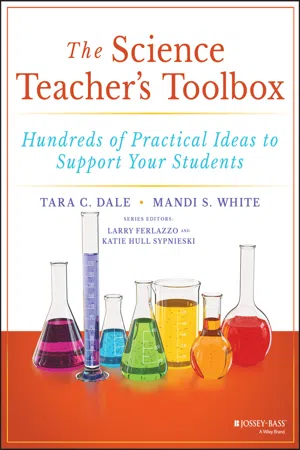
The Science Teacher's Toolbox
Hundreds of Practical Ideas to Support Your Students
- English
- ePUB (mobile friendly)
- Available on iOS & Android
The Science Teacher's Toolbox
Hundreds of Practical Ideas to Support Your Students
About this book
A winning educational formula of engaging lessons and powerful strategies for science teachers in numerous classroom settings
The Teacher's Toolbox series is an innovative, research-based resource providing teachers with instructional strategies for students of all levels and abilities. Each book in the collection focuses on a specific content area. Clear, concise guidance enables teachers to quickly integrate low-prep, high-value lessons and strategies in their middle school and high school classrooms. Every strategy follows a practical, how-to format established by the series editors.
The Science Teacher's Toolbox is a classroom-tested resource offering hundreds of accessible, student-friendly lessons and strategies that can be implemented in a variety of educational settings. Concise chapters fully explain the research basis, necessary technology, Next Generation Science Standards correlation, and implementation of each lesson and strategy.
Favoring a hands-on approach, this bookprovides step-by-step instructions that help teachers to apply their new skills and knowledge in their classrooms immediately. Lessons cover topics such as setting up labs, conducting experiments, using graphs, analyzing data, writing lab reports, incorporating technology, assessing student learning, teaching all-ability students, and much more. This book enables science teachers to:
- Understand how each strategy works in the classroom and avoid common mistakes
- Promote culturally responsive classrooms
- Activate and enhance prior knowledge
- Bring fresh and engaging activities into the classroom and the science lab
Written by respected authors and educators, The Science Teacher's Toolbox: Hundreds of Practical Ideas to Support Your Students is an invaluable aid for upper elementary, middle school, and high school science educators as well those in teacher education programs and staff development professionals.
Frequently asked questions
- Essential is ideal for learners and professionals who enjoy exploring a wide range of subjects. Access the Essential Library with 800,000+ trusted titles and best-sellers across business, personal growth, and the humanities. Includes unlimited reading time and Standard Read Aloud voice.
- Complete: Perfect for advanced learners and researchers needing full, unrestricted access. Unlock 1.4M+ books across hundreds of subjects, including academic and specialized titles. The Complete Plan also includes advanced features like Premium Read Aloud and Research Assistant.
Please note we cannot support devices running on iOS 13 and Android 7 or earlier. Learn more about using the app.
Information
PART I
Science Labs

CHAPTER 1
Strategies for Teaching Lab Safety
What Is It?
Why We Like It
Supporting Research
Skills for Intentional Scholars/NGSS Standards
Application
SCIENCE SAFETY CONTRACT
LAB SAFETY RULES STORY
OTHER INTERACTIVE WAYS TO TEACH LAB SAFETY
- Draw a cartoon showing what happens when lab safety rules aren't followed.
- Produce a video explaining why it's important to follow lab safety rules.
- Write and act out a skit that demonstrates the lab safety rules. Have small groups create two skits each—one showing how to correctly follow lab rules and the other showing an example of not following them. Not only can students have fun with this juxtaposition, but showing ...
Table of contents
- Cover
- Table of Contents
- List of Tables
- About the Authors
- About the Editors of the Toolbox Series
- Acknowledgments
- Letter from the Editors
- Introduction
- PART I: Science Labs
- PART II: Integration of ELA, Mathematics, and the Arts
- PART III: Additional Resources
- References
- Index
- End User License Agreement